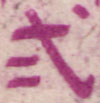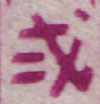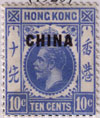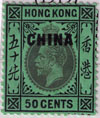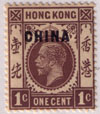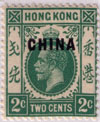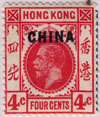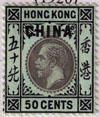1st Issue (MCAA Printings)
On 17th August 1916, De La Rue confirmed the final quantities to be printed under the first (or 'Nil') requisition, which are listed in the first table.
The first issue of stamps was sent to Hong Kong on 6 November 1916 and Wolfe confirmed that they had been brought into use on 1 January 1917.
During earlier discussions about Treaty Port issues in 1911, the Governor of Hong Kong had stipulated that the Hong Kong stamps would be valid for use in the treaty ports for a period of one year from the date that they ceased to be sold. This may have remained in place, but Wolfe also requested in his letter to the GPO on 7 November 1916 that ‘the stamps are to be brought into use on 1st January next, and to return to this office all Hong Kong stamps unsold on that date.’ Consequently, usages of the unoverprinted stamps on mail from the Treaty Ports after January 1, 1917 are extremely rare, as are combination usages of both overprinted and unoverprinted stamps. As late as 2008, only one cover and two pieces showing these combinations had been found and only two covers have ever been reported as being used in 1917 with only un-overprinted Hong Kong stamps. A couple of attempts (possibly successful) were made to use the overprinted stamps outside of the Treaty Ports such as this pair, dated 18 April 1919
| Date | Origin | Destination | Franking |
|---|---|---|---|
| Feb 5 1917 | Canton | HKSC 347/8 | |
| Feb 8 1917 (Single) | Ningpo | $0.02 | |
| Feb 13 1917 (Single) | Amoy | $0.04 | |
| Aug 26 1917 | Shanghai | Philippines | $0.10 |
| Aug 27 1917 | Shanghai | Great Britain | $0.10 |
| Date | Origin | Destination | Franking |
|---|---|---|---|
| Jan 13 1917 (Partial) | |||
| Jan 29 1917 | Shanghai | Japan | $0.14 |
| Jan 31 1917 (Partial) | Shanghai | $0.26 | |
| Feb 16 1917 (Partial) | Shanghai | $0.10 | |
| Feb 24 1917 | Shanghai | Great Britain | $0.26 |
| Mar 12 1917 | Shanghai | Great Britain | $0.10 |
| Apr 18 1917 | Chefoo | Great Britain | $0.20 |
| May 24 1917 | Shanghai | Great Britain | $0.10 |
| Jul 24 1917 | Shanghai | Great Britain | $0.10 |
| Aug 27 1917 | Hankow | $0.20 | |
| Sep 11 1917 | Shanghai | India | $0.26 |
| Oct 2 1917 | Shanghai | India | $0.20 |
| Oct 13 1917 | Shanghai | India | $0.12 |
| Oct 18 1917 | Shanghai | $0.22 | |
| Oct 20 1917 | Chefoo | Great Britain | $0.10 |
| Nov 19 1917 | Shanghai | USA | $0.68 |
The Nil Requisition - Special Printing
The De La Rue Private Day Books held by the National Mail Archive prove that the numbers of sheets listed above were a special printing of the regular Hong Kong issues specifically made for overprinting. On October 13, 1916, and from De La Rue requisition 70/16, (Page 1) (Page 2)De La Rue forwarded this printing to Somerset House, where the 'China' overprint was applied1. Usually one sheet of each denomination was pulled from the printing and signed off as a registration copy to show approval of the printing, but for unknown reasons, in this particular case, two sheets were taken and are in the possession of the British Library Philatelic Collection and the British Postal Museum and Archive.
For examination purposes, the 'Nil' requisition was printed before the regular Hong Kong 'F'; requisition.
| Value | Color | Requisition | Qty Ordered from De La Rue | Qty Printed / Sent by De La Rue | |
|---|---|---|---|---|---|
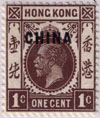 |
1 cent | Black-Brown | Nil | 1300 | 1345 |
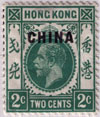 |
2 cents | Deep Blue-Green | Nil | 5500 | 5512 |
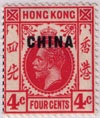 |
4 cents | Scarlet | Nil | 5200 | 5365 |
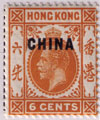 |
6 cents | Brown-Orange | Nil | 800 | 825 |
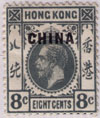 |
8 cents | Slate | Nil | 400 | 412 |
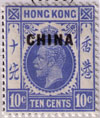 |
10 cents | Deep Bright Ultramarine | Nil | 7200 | 7174 |
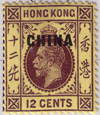 |
12 cents | Purple on Yellow/Yellow Back | Nil | 150 | 155 |
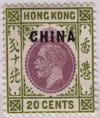 |
20 cents | Purple and Sage Green | Nil | 275 | 273 |
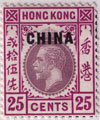 |
25 cents | Purple and Magenta | Nil | 50 | 68 |
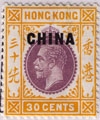 |
30 cents | Purple and Orange-Yellow | Nil | 175 | 186 |
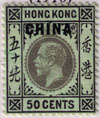 |
50 cents | Grey-Black on Blue Green, Pale Olive Back | Nil | 200 | 213 |
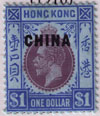 |
1 Dollar | Reddish Purple and Bright Blue on Blue | Nil | 100 | 109 |
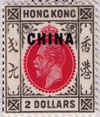 |
2 Dollar | Carmine-Red and Grey-Black | Nil | 20 | 32 |
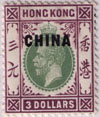 |
3 Dollar | Green and Purple | Nil | 20 | 32 |
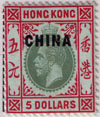 |
5 Dollar | Green and Red on Blue-Green, Olive Back | Nil | 20 | 33 |
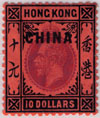 |
10 Dollar | Purple and Black on Red | Nil | 20 | 33 |
The 'A' Requisition - Special Printing
| Value | Color | Requisition | Qty Ordered from De La Rue | Qty Printed / Sent by De La Rue | |
|---|---|---|---|---|---|
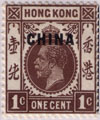 |
1 cent | Brown | A | 500 | 809 |
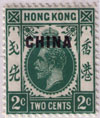 |
2 cents | Deep Green | A | 5250 | 5360 |
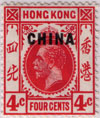 |
4 cents | Carmine-Red | A | 5250 | 5406 |
 |
6 cents | Brown-Orange | A | 700 | 714 |
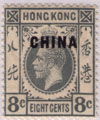 |
8 cents | Grey? | A | 475 | 488 |
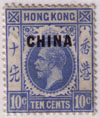 |
10 cents | Dull Ultramarine | A | 5200 | 3282 |
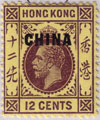 |
12 cents | Purple on Pale Yellow/Yellow Back | A | 200 | 204 |
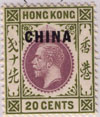 |
20 cents | Purple and Deep Sage Green | A | 300 | 300 |
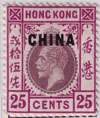 |
25 cents | Dull Purple and Bright Magenta | A | 150 | 155 |
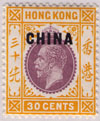 |
30 cents | Dull Purple and Orange-Yellow | A | 250 | 255 |
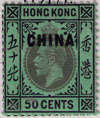 |
50 cents | Grey-Black on Emerald, Pale Olive Back | A | 250 | 234 |
 |
1 Dollar | Reddish Purple and Bright Blue on Blue | A | 100 | 103 |
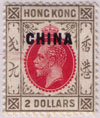 |
2 Dollar | Carmine-Red and Bistre | A | 20 | 23 |
On September 26, 1918 De La Rue was informed that the character on the 25c was incorrect and were requested to make appropriate changes to add the missing stroke to the Chinese character. By the 3rd of October De La Rue had put in the border die and plate for the new 25 cent stamp.
As no further orders of the 25c were made for overprinting of the first issue, the corrected version did not appear on the China overprints until Requisition F.
The 'Unknown' Requisition
On 7th October, 1918, De La Rue received a requisition for 10,000 1 ½ cent postcards (what would become the 1 ½ cent Orange) under Requisition 102/18.
This would be printed as part of the regular Hong Kong Requisition number 99/18 but interestingly, 125 sheets of the 25c were also requested as a part of this requisition.
At this time, this does not appear to fall into any known requisition and it is unclear whether they were ever printed.
The 'B' Requisition
On 27 January 1919 the Crown Agents placed an order for regular Hong Kong stamps with added quantities intended for overprinting. This would become the first issue printed at the same time as a regular Hong Kong issue. On 6th February 19196th February 1919, De La Rue received requisition 8/19, which would printed in conjunction with the Hong Kong requisition 6/19, this would become known as Requisition B.
Quality Issues
At the same time, the Postmaster Shanghai wrote to the PMG Hong Kong (Part 1) (Part 2) complaining that the quality of the gum on the 10 cent was problematic and that the stamps were sticking to the tissue sheets by which they were separated. He acknowledged that the climate was responsible but that 'ordinary moistening on the tongue will practically remove the gum and leave plain paper,’ and further suggested that the stamps be triple gummed in the future. This complaint was then passed up to the GPO by the PMG Hong Kong on February 13th
On the 9th April 1919 (Part 1) (Part 2) , De La Rue responded that the stamps showed signs of having been subjected to high temperatures in transit to Shanghai, which would have contributed to the problem, but the stamps were also being printed on lower quality paper due to the war.
The GPO replied to the Postmaster Hong Kong stating that no complaints had been received by either the public or from any of the other Agencies so the shipment from Hong Kong to Shanghai may have been at fault. They also stated that additional gum would cause the sheets to adhere to each other and would not be recommended.
The 'C' Requisition
On November 18 1919, the Crown Agents placed an order for 800 sheets of the 20c issue. This would become the ‘C’ requisition
| Value | Color | Requisition | Qty Ordered from De La Rue | Qty Printed / Sent by De La Rue | |
|---|---|---|---|---|---|
 |
20 cents | Purple and Deep Sage Green | C | 800 | 800 |
The Broken Crown
The Broken Crown variety appeared on the 1c brown stamp of both the Hong Kong and China Overprints.
Although the stamps had been printed for some time, there had been two requisitions of these stamps sent to the Agencies (the Nil and the 'A' requisition), it was not until the 2nd February 1920 that Postmaster of the British Post Office at Shanghai brought the matter to the attention of the authorities. He pointed out that errors were being bought locally as 'philatelic curiosities' and asked whether the Hong Kong PMG had been made aware of the error as he assumed that this was appearing on the Hong Kong issues as well and asked whether the unissued sheets would be withdrawn or if the defective plates would be discarded or corrected for future issues.
On the 10th February, 1920, De La Rue responded that the plate in question was satisfactory and that in printing 'a sheet of paper may have sustained a particle of hard substance which damaged the overlay'
The 'D' Requisition
Requisition D is particularly interesting because until now, the items and quantities had been unknown
It now appears that there were two separate requirements made by the Agencies: The first, a telegram around May 28 1920, urgently requested the 2c, 6c, and 50c and the second, a telegram on July 8 1920, ordered the 1c, 4c, 8c and 10c.
This same requisition ordered 6,000 of the 4c postal card and 1,000 Size F, 7,000 Size G, 2,500 Size H, 1,000 Size H2 and 2,500 of the Size K Registered Envelopes.
No mention has been made in any of the literature of this requisition and this seems to be the first time that it has been noted.
The De La Rue Daybook dated 3rd September 1920 shows the numbers for the 2c, 6c and 50c. In addition, on 10th November 1920, the Crown Agents complained that the entire Hong Kong requisition was overdue. De La Rue responded to this on 22nd November 1920 saying that a lack of skilled labor was the cause of delay in production of the envelopes and that introduction of the new watermarked paper (the script issue) was the cause of delay in the production of the stamps.
On the 24nd November 192024nd November 1920, the Crown Agents responded that they did not understand the explanation as it was their understanding that the order for the new paper had been issued in August 1920 and was of the old design (that of the regular MCA).
The 'E' Requisition
Requisition E was sent by the Crown Agents to De La Rue on 23rd February 1921 with a follow up on 3rd March 1921 requesting that these stamps be expedited.
| Value | Color | Requisition | Qty Ordered from De La Rue | Qty Printed / Sent by De La Rue | |
|---|---|---|---|---|---|
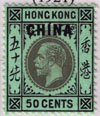 |
50 cents | Olive Bistre on Emerald, Blue Back | E | 500 |
|
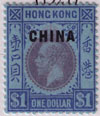 |
1 Dollar | Grey-Purple and Blue on Blue | E | 375 |
|
The 'F' Requisition - 50 Cents Only
| Value | Color | Requisition | Qty Ordered from De La Rue | Qty Printed / Sent by De La Rue | |
|---|---|---|---|---|---|
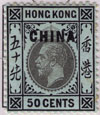 |
50 cents | Grey on Blue Green, Blue Back | F | 750 | 770 |
The 50 Cent Printings - Shades and Other Issues
On the 26th of September 1916, the Governor of Hong Kong sent a note to the Crown Agents noting that the color of the 50 cent Hong Kong Postage stamps was markedly different from the color of the specimen stamps
This was forwarded to De La Rue, who responded on the 28th of September that the change in the density of color on the doubly-fugitive black was due to the fact that the materials used in the manufacture of the color had previously been sourced from Germany, with whom Britain was now at war
They noted that the other properties of the color were consistent with their standards and that the density was the only point of difference. While these documents specifically refer to the Hong Kong issues, this explains the vast range of color to be found on the 50c issues. There is still examination to be done to confirm the shades to the printings.
From Halewood/Antscherl, we can find the following:
- 50c HK F Requisition (May 1917) Black/blue green? Olive Back
- 50c HK L Requisition (Oct 1920) Grey bistre & black on emerald with pale green back
- 50c HK O Requisition (Aug 1922) Light Grey bistre & black on olive? with emerald back
- 50c HK U Requisition (Before 1928) Black on emerald (Grey black & black on emerald?) Perrin stated:
- 50c Nil Grey Black on Blue-Green with Pale olive back
- 50c A Grey Black on Emerald with Pale olive back
- 50c B Grey Black on Emerald with emerald back
- 50c D Grey Black on Blue Green with White back
- 50c E Olive Bistre on Emerald with blue back
- 50c F Grey on Blue Green with Blue back
- 50c H Deep Grey on Deep emerald with emerald back
- 50c J Bistre on Deep emerald with White back
Gibbons lists 4 varieties of the 50c China overprint with the white back variety from 1920 being the most rare and valuable.
Perrin lists 6 varieties, again with the white back listed as the most rare.
An article in the HKSC published April 2011 by Nick Halewood lists only 5 requisitions for the 50c China overprint (No letter, A, B, D and E).
What is missing is that the first of the Script watermark (Requisition F) used the MCA paper for the 50c so the F requisition is also included in this.
(Bear in mind that the B and D requisitions were printed in conjunction with regular Hong Kong printings and the others were completely different and special printings of the Hong Kong stamps specifically for the purpose of being overprinted.)
Peter Fernbank, in the footnotes to the Halewood article, took this all a bit further by checking on this and showing that what Perrin and Gibbons are referring to with the white back (for the China overprints only) is actually one of the two types of pale olive (one shade of which is a pale olive and the other a very pale green but they both get lumped under the pale olive). The white back on HK111A came from paper that had all been used up by 1920.
What Perrin and Gibbons refer to as the 'white back' on the ‘China’ overprints is actually the grey-black/emerald surface with very pale olive.
The actual colors of the requisitions are now in great confusion as well as the dates previously assigned.
The E requisition is definitely Olive Bistre/Emerald with a back that is somewhere between a Blue Green/Emerald color. Halewood has also stated that the D Requisition is definitely the Grey-Black/Blue Green with Pale Olive back
1 - De La Rue Private Day Book p.57, British Postal Museum and Archive
